Joshua is the founder and CEO of Industrial Logic, one of the oldest and most well-respected agile consultancies on the planet. Since 1996, Joshua and his global network of colleagues have helped people in teams across many industries leverage the wisdom and power of modern product development methods.
An early pioneer and practitioner of Extreme Programming, Lean Software Development and Lean Startup, Joshua most recently crafted Modern Agile to help people and organizations benefit from a principle-based approach to agility.


